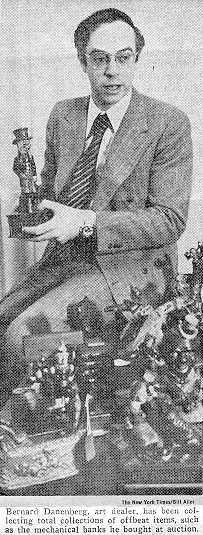NEW YORK TIMES — March 12, 1974, Page 28, By RITA REIF
If Collection Appeals to Them,
They Buy It All
 Bernard Danenberg, the Madison Avenue art dealer,
says he and his wife are "collecting collections." Not paintings and sculptures
— that’s nothing unusual among dealers — but tools, mechanical banks and
pottery, the sort of offbeat collectibles that have increasing popular appeal of late.
Bernard Danenberg, the Madison Avenue art dealer,
says he and his wife are "collecting collections." Not paintings and sculptures
— that’s nothing unusual among dealers — but tools, mechanical banks and
pottery, the sort of offbeat collectibles that have increasing popular appeal of late.
"We’re doing it for the same reason other people buy gold bullion," Mr. Danenberg explained. Of course, he added quickly, even though he regards collections as a hedge against inflation, "if the offer is right, I’ll sell anytime — I’m a merchant."
Mr. Danenberg said he knows of no other dealer who has moved into the collectibles market in the same way, including his plan not to sell off the collections piece by piece. If he can’t find buyers interested in acquiring the collection intact, Mr. Danenberg has other plans: he’ll hold exhibitions of them or rent them out.
Mr. Danenberg’s first move occurred in late January in a French village not far from Orleans where he purchased a collection of 3,000 vintage tools. "I can’t believe I bought the whole thing," said the dealer jokingly. But he did. He said he paid $30,000 for the assemblage of 18th and early 19th-century axes, and calipers, a collection amassed by a landowner and stored in a vacated monastery. He expects to edit the collection down to about 500 items and insists the purchase was not much of a gamble.
"The French and the English are already well into collecting tools," Mr. Danenberg said. And, he noted, there are several antiques shops specializing in tools that have opened in Paris recently. Mr. Danenberg said he considers all these as signs for a boom in period tool sales.
Mr. Danenberg and his wife, Elizabeth, aren’t always successful in buying complete collections, but when they can’t, they make it a point of purchasing sizable parts of them.
While her husband was negotiating for the tool collection in France, Mrs. Danenberg bought — for $27,920 — 78 of the 202 lots of 19th-century pottery owned by Jacqueline D. Hodgson in a sale at Southeby Park Bernet. The chunky wares now fill several shelves in the Danenberg Gallery basement, 1020 Madison Avenue (near 78th Street).
The thickly modeled pottery, most of which boasts Rockinghan-type brown glazes, all seem, esthetically speaking, eons away from Mrs. Danenberg’s other pottery collections in that basement — 400 pieces of Picasso clay works. But she loves both and said she has no intention of parting soon with either.
"She won’t sell the pottery at any price," her husband said.
Why?
"The time is not ripe for it," Mrs. Danenberg explained. "With the bicentennial coming — well, maybe then."
Several weeks ago Mr. Danenberg popped in to see the mechanical banks that Southeby’s P. B. 84 was to auction. He poked at the buttons that make Boss Tweed, Uncle Sam, Humpty Dumpty and Uncle Remus characters come alive with action and then paid $14,195 for 36 of the 63 sold.
"The price represents about half a Utrillo and I think the banks will escalate faster than some oils," he said.
Dickering for More
The 37-year old dealer led the way through the gallery hung with French Impressionist and
Post-Impressionist paintings and up the stairs, to an upper floor where he keeps the banks
in a locked closet.
Inside were row on row of the painted iron coin-gobblers, turn-of-the-century toy-like trivia that have skyrocketed in price in recent years. Not all were from the P.B. 84 sale. Since the auction, he’s bought another 20 action banks and is dickering with a collector for 200 more, he said.
He is also discussing the possibility of a mechanical bank book with Harry Abrams, publisher of those highly successful coffee table volumes on Norman Rockwell and Walt Disney.
It was an exhibition in 1968 of Rockwell’s Saturday Evening Post oils that was Mr. Danenberg’s first departure from the fine arts field. "Norman Rockwell told me that he had never sold an illustration as a painting until that time," Mr. Danenberg recalled. (His gallery now sells several each year.)
Mr. Danenberg is not saying where or what he intends to buy next. In fact, right now he is trying to see if he can work his mechanical banks into a suggestion he made to the Walt Disney people — a cartoon film of Norman Rockwell’s work.
